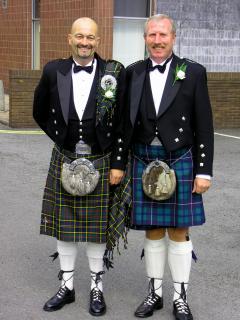Tips and Tricks for Wearing Your Kilt OutfitsPosted by Arpin Gajjar on July 1st, 2019 Regardless of your reasons for wearing a kilt, it’s imperative that you understand how to do so correctly. We want to share some of the best tips and tricks for ensuring that your kilt looks impressive and masculine, rather than making it seem like you put on your sister’s skirt.
Kilts - Formal vs. CasualIn many cases, men will wear kilts for a formal occasion, such as a wedding. However, because this fashion icon is becoming more mainstream, there are plenty of more casual options available. Thus, the first thing you need to understand is that wearing a formal kilt is far different than tossing one on to go out to the pub. For one thing, formal kilts have a lot of accessories, and they are a bit more high-class. Assuming that you don’t want to do a whole song and dance every time you leave the house, it’s better to opt for a more casual version. That being said, having a formal kilt for those special occasions is always recommended, and we’ll cover the various components you may or may not want to include in your everyday wear. One of the great things about kilts is that it’s a lot easier to dress up or down, based on your situation. Anatomy of a Kilt When looking at a kilt, there are a few elements you need to understand before getting started. First, the cloth is divided into a front and a back section. The exterior is called the apron, and it’s flat and smooth. The rear has pleats, which is how you know which direction to put the kilt on in the first place. Each kilt has one or more belts with buckles. Usually, the right side is under the apron, meaning that it goes underneath the left side (or front apron). In some instances, your kilt may have a third buckle, but that’s often reserved for more formal options. When you see most men wearing a kilt, there is a piece called a sporran in the front. For formal wear, this piece is made of fur. For casual wearers, the sporran is most often leather or some other material. You don’t need a sporran to wear a kilt, but it’s a fashionable accessory, and many of them can be functional as well, offering a means of carrying items that would generally go in your pockets. Along with the kilt, you can choose to wear flashes, socks, and Ghillie Brogues. These pieces can be rather formal or casual, depending on the occasion. We’ll get into how to wear them correctly later in this article. Finally, if you’re feeling saucy or you want to represent your Scottish (or Irish) heritage, you can wear a kilt pin. Typically, these pins represent your clan or family crest, but you can also find various pins that just look cool.  Tips for Getting Your Kilt Just RightIf you haven’t worn a kilt before, it can take a little bit of practice to make it look good. Let’s go over the basic steps before getting to the more advanced stuff. Wear it On Your Waist The placement of your kilt should be just below the navel. If it’s too high, it can look silly, and if it’s too low, it will feel weird and uncomfortable. Don’t Fasten it Too Tight Ideally, you should be able to get your thumbs underneath the belt. If it’s too tight, you’ll be uncomfortable whenever you bend over or sit down. Put Your Shirt on First If you try tucking in your shirt after the kilt is fastened, you’ll realize why we mention this. For casual kilts, you can often find shirts that complement the pattern. Both t-shirts and button-downs look good, so don’t assume that you have to dress up. As a note, untucked shirts with a kilt look odd, so don’t try it. Check the Shape Your kilt should have a definite A shape to it. If it’s bunched up by the waist or looks too flat along the sides, you’ll need to readjust it and start over. Make Sure the Pivot Point is in the Middle The pivot point is where the kilt pattern mirrors itself. This line should be in the center of your body. If it’s angled, you need to readjust your belts to get it right. Wear Underwear Just because the traditional Scots didn’t have undergarments doesn’t mean you shouldn’t. Not only can it feel strange to go “commando,” but you want to make sure that you’re not putting on a show every time there’s a wind. Get Fitted for Your Kilt Until you’ve bought and worn a few kilts, it can be tricky to find the right size. If possible, go to a tailor who specializes in kilts who can ensure that it will fit well. Don’t Hang Your Sporran Too Low The Sporran should hang about one hand’s length from the top of the kilt. If it’s too low, it will bounce too much when you walk. The Sporran is not only there to hold your belongings, but it weighs down the front of the kilt so that it doesn’t billow too easily. Attach the Kilt Pin to the Front Apron Again, kilt pins are usually reserved for formal occasions, but they also serve a more practical purpose, which is to keep the wind from blowing the side of the kilt up too far. If you have a pin, attach it to the front apron only. When Wearing Hose and Flashes You don’t need to put on hose and flashes every time you wear a kilt, but if you, here are a few things to remember: Put the Hose on First - Pull it up past the knee, then attach the flashes Keep Flash Patterns With Matching Kilts - It looks weird if they clash Flashes Go Just Below the Knee - They’re like garters, so attach them below the knee, then pull the hose down over them so that your knee is exposed Wear Flashes to the Front or Side - Whichever you choose, make sure both sides are matching Overall, wearing a kilt can be a rewarding experience, and once you get used to the feeling, you’ll likely prefer them over regular pants. We highly recommend practising these different tips in the mirror so that you can see how you look before heading out in public. Kilts can be remarkably flattering, but only when you put them on correctly. Like it? Share it!More by this author |



